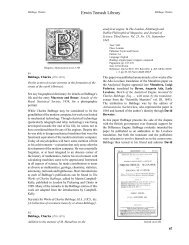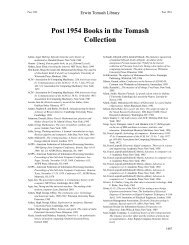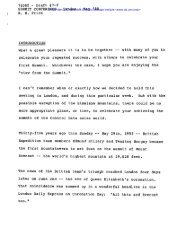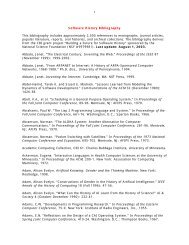M chapter.indd - Charles Babbage Institute
M chapter.indd - Charles Babbage Institute
M chapter.indd - Charles Babbage Institute
You also want an ePaper? Increase the reach of your titles
YUMPU automatically turns print PDFs into web optimized ePapers that Google loves.
870<br />
Erwin Tomash Library<br />
Mercator, Nicolaus Meredith, Nicholas<br />
Nicolaus Mercator, not to be confused with Gerardus<br />
Mercator, was born in Cismar, Holstein (then part of<br />
Denmark). He attended the University of Rostock and<br />
after graduation held a teaching post there. He then<br />
received an appointment at the University of Copenhagen.<br />
That institution was closed in 1660 due to the plague,<br />
so Mercator moved to London. There, in 1666, he was<br />
one of the founding members of the Royal Society.<br />
He remained in London until 1682, when he moved to<br />
France to design the waterworks at Versailles.<br />
Mercator is known for his writings on cosmography,<br />
trigonometry and logarithms and for editing an edition<br />
of Euclid’s Elements. In this work he shows how<br />
logarithms may be calculated and introduces the series<br />
(log(1+x) = x – x 2 /2 + x 3 /3 – x 4 /4 ….) that is now known<br />
as the Mercator series. It is said that this work inspired<br />
Mercator’s contemporary Isaac Newton to write his<br />
famous paper De analysi giving an account of infinite<br />
series.<br />
Illustrations available:<br />
Title page<br />
M 88<br />
M 88<br />
Mercator, Nicolaus [Niklaus Kauffman] (1620–1687)<br />
Trigonometria sphæricorum logarithmica, præceptis<br />
rotüdis ac planè sphæricis, quibus nihil addere<br />
possis, neque demere; cum canone triangulorum<br />
emendatissimo, continente logarithmos sinuum<br />
& tangentium ad singula graduum quadrantis<br />
minuta prima, & ad radium 100000.00. Posterioris<br />
formæ, præstantiâ & commoditate, illustri Nepero<br />
commendatâ, priorem longè superantis<br />
Year: 1651<br />
Place: Danzig<br />
Publisher: Andreas Hünefeldt<br />
Edition: 1st<br />
Language: Latin<br />
Binding: contemporary vellum boards<br />
Pagination: pp. [4], 12, [4], [94]<br />
Collation: A 10 B–F 8 G 7 (A9–A10 blank)<br />
Size: 162x94 mm<br />
This is Mercator’s logarithm table. After a short<br />
introduction explaining the use of logarithms in the<br />
solution of triangles, it gives values for the sine, cosine,<br />
tangent and cotangent function at one-minute intervals.<br />
Two blank pages are bound between the introduction and<br />
the tables that were evidently supposed to contain the<br />
figures referred to in the text. Whether these pages were<br />
originally blank or a later introduction is not clear. The<br />
two blank pages are of different paper than the others in<br />
this volume, and they have a watermark that is not seen<br />
elsewhere.<br />
Illustrations available:<br />
Title page<br />
Colophon<br />
Table page<br />
M 89<br />
Meredith, Nicholas (1770–1801)<br />
M 89<br />
The description and use of pocket cases of<br />
mathematical, or drawing instruments …<br />
Year: [1790]<br />
Place: London<br />
Publisher: Author<br />
Edition: 1st<br />
Language: English<br />
Figures: 3 engraved plates (1 folding)<br />
Binding: three-quarter bound leather over marbled boards<br />
Pagination: pp. iv, 47, [1]<br />
Collation: π 2 B–D 8<br />
Size: 210x128 mm







